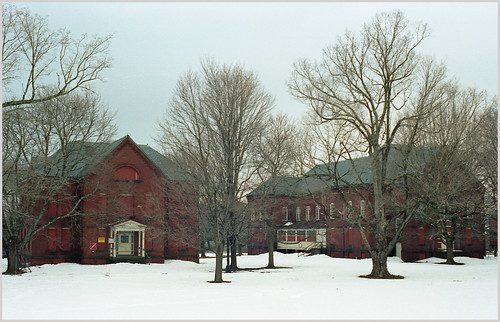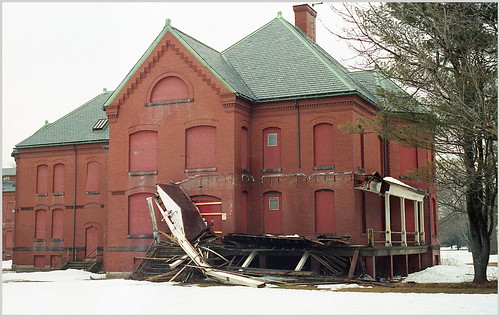From Derek Watt:

Medfield State Hospital, originally Medfield Insane Asylum, was established in 1892 and open from 1896-2003. Built in the then-popular “Cottage Plan” style, where dozens of individual buildings served a specific need or patient type, each side of the property featured buildings arranged in a mirror image, one side for men, one for women. A chapel, administrative and other general purpose buildings were located in the middle.

Much like other state-run hospitals of the time, Medfield was self-sufficient (see August 23, 2010, "You Don't Have to Be Crazy to Live Here, But It Helps," a headline that I regret writing -- DB). A power plant situated on the edge of the property provided electricity and heat. Hundreds of acres of fields provided food for the staff and patients. Medfield’s farm operations were so successful that in some years, a surplus of food was generated and sent to other state hospitals in Massachusetts. At its peak, Medfield housed more than 2,300 patients. Hundreds of staff members also lived on campus in large staff dorms flanking the outer edges of the property.
Changes in psychiatric care during the 1950s with the introduction of drug-based therapy, coupled with new legislation around the treatment of mental illness into the '60s, led to a steady decline in patient levels. In the late 1970s, records indicate that buildings on campus started to become shuttered and abandoned. This trend continued until the hospital was finally closed for good in 2003.



In 2008 Medfield was one of the primary filming locations of the movie "Shutter Island" (see August 27, 2010, "Shuttered Island," about how Boston Harbor's Peddocks Island was also featured in the Martin Scorsese movie).
The state of Massachusetts retained ownership of the property until 2014, when it was sold to the town of Medfield. Currently the town is investigating various options for reuse and redevelopment of the property. The hospital grounds are currently open to the public from dusk to dawn.
All of the pictures featured here were taken from 2014-2016.

























